This was published 2 years ago
Victoria's best regional art galleries: A road-trip from Wodonga to Bendigo to Geelong
By Julietta Jameson
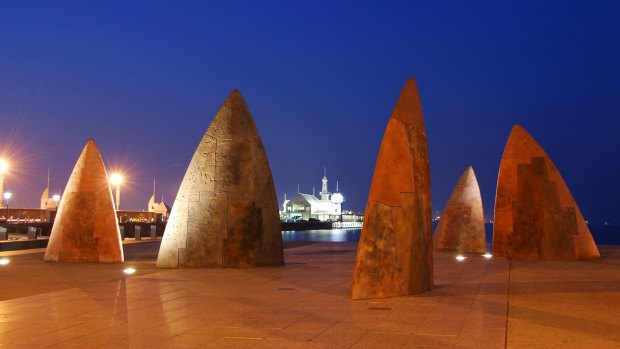
Sculptures on the Geelong waterfront.
Its soaring, 30-metre-high sculptural facade with an imposing metallic finish makes the Denton Corker Marshall-designed art museum one of the newest, most striking buildings in Australia. But this is not the latest architectural statement in Melbourne or another major city like Sydney, Brisbane, Adelaide or Perth for that matter.
No, this powerful landmark rises not above a crowded skyline but from the bucolic Goulburn Valley plains in the regional city of Shepparton, with a population of about 50,000, two hours north of Melbourne and seven hours south of Sydney.
Inside, the Shepparton Art Museum, or SAM for short, the most significant collection of historic and contemporary Australian ceramics in regional Australia sits beside an incredibly diverse congregation of Aboriginal and Torres Strait art with emphasis on the south-east of the country.
Melbourne may be regarded as the nation's cultural capital but nowadays it is surrounded by a formidable artistic rival: Victoria, the state as a whole with its tapestry of accessible regions, is itself awash with an expanding number of remarkable regional art galleries and museums, some of them architectural statements to rival any major city.
The director of the Benalla Art Gallery, Eric Nash, says it's a real treat to explore the arts across the state.
"There's a richness and diversity of high quality offerings, and it's driven by artists and arts workers throughout the state who are passionate about the work they do and how their work resonates with audiences. Victoria is also so well set up for day trippers and tourists seeking arts experiences. Part of that is because of the strong network of amazing galleries located both in Melbourne and throughout the regions, and part of that is geography."
From Mildura in the far north-west, to Morwell in the south-east, every one of Victoria's 12 official regions are home to at least one noteworthy gallery or museum. As manufacturing has contracted, historic, often cavernous factories and warehouses have emptied with cultural tourism-minded regional communities finding ingenious ways to convert and use them for the cultivation of creativity.
Combine these state-wide cultural gems with Victoria's comparative geographic compactness, along with some outstanding accommodation choices, and art lovers can easily string together a road trip hit list brimming with top-notch cultural experiences.
Traveller has devised a near week-long itinerary that packs plenty of punch and is easily broken into one-to-four days or four-to-seven. Use it as inspiration for slower travel and a deeper dive into each destination, or break it up, a weekend at a time.
Whichever way you choose to travel, go now and enjoy. Culture vultures, it's time to take flight beyond the city limits with Victoria by far the best state in which to do so.
DAY ONE: MELBOURNE TO GEELONG, 74 KILOMETRES
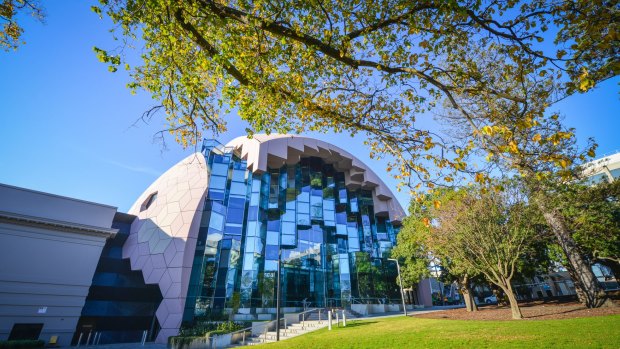
As I head across the Westgate Bridge outbound from the Victorian capital to begin my cultural road trip, I'm enroute to one of only 40 centres in the world designated as a UNESCO City of Design. It's the only one in Australia, and it's not Victoria's largest city but its second biggest.
Geelong, with a population of about 265,000, won the mantle by being the birthplace for such innovations as the Hills Hoist, the ute, our decimal coins and even the commercial fridge (visitgeelongbellarine.com.au). The wool press is another great Geelong invention and when I reach G-town, as Victorians affectionately call the Corio Bay city, it's the region's wool producing past that is the backdrop to much of the modern creative scene.
The Federal Woollen Mills site in North Geelong, a striking example of industrial art deco architecture (federalmills.com.au), is now a multi-purpose business and retail site. After a quick stop (and shop), I head to the CBD to visit the National Wool Museum (geelongaustralia.com.au), an engaging telling of one of post-settlement Australia's most important stories.
It's housed in the 1872 bluestone Dennys Lascelles Wool Store and features a collection of more than 7500 objects, including a huge 1910 loom that still makes rugs to order. I find the audio-visual "Welcome to Country" presentation from the local Wadawurrung people to be poignant and admire the museum for broaching the impacts of farming on the First Nations people.
From here, I stroll to the Geelong Gallery (geelonggallery.org.au), one of the oldest in Victoria, established in 1896, where, behind the grand classical facade, is a home to some of Australia's most significant paintings, including Frederick McCubbin's moving "A bush burial". It was among the first acquisitions that helped build up a strong, 6000-piece permanent collection.
As much as Geelong's arts area says about its history, it also speaks much about the contemporary nature of of the city in the form of the architectural brilliance of the neighbouring Geelong Library and Heritage Centre, also known as the The Dome, by ARM Architecture, as well as the translucent brilliance of the Arts Centre redevelopment by Hassell Architects.
Emblematic too, of contemporary Geelong's vibrant arts community is Boom Gallery (boomgallery.com.au), a brilliantly-curated collection of art for sale, (much of it at approachable prices). It's in another reclaimed former wool mill on cool Pakington Street.
I check into the stylish and supremely comfortable new R Hotel (rhotelgeelong.com.au) in time to catch the sunset over Corio Bay, itself a work of art, from the large balcony of my water-view apartment. The hotel is yet another example of clever reworking of a Geelong heritage building.
DAY TWO: GEELONG – BALLARAT – BENDIGO, 200 KILOMETRES
It's less than 90 minutes' drive due north to Ballarat, a city of 114,000 people, where I visit the oldest and largest regional gallery in Australia. With a focus on the history of Australian art, the collection of the Art Gallery of Ballarat's (artgalleryofballarat.com.au) is nationally significant, with major names represented and displays constantly changing.
My Ballarat visit is a bit of a whistle stop, but I make time to drop by the Eureka Centre (eurekacentreballarat.com.au) as well, where the original Eureka Flag is held, an important remnant from the 1854 rebellion, a bloody revolt against colonial rule.
Next, I head an hour north to Castlemaine, Victoria's newest boho honeypot of 7000 or so souls which attracts arty types to its eclectic lifestyle offerings.
Art abounds here but my main objective is a visit to the Castlemaine Art Museum (castlemaineartmuseum.org.au) founded in 1913, where a collection of Australian art and historical artefacts reflecting the early history of the district is housed in a beautiful art deco building. The atmospheric 1887 Tom Roberts work "Reconciliation" is a moving highlight.
After driving an easy 30 minutes to Bendigo, a regional city of 120,000, I check in to my cosy glamping tent at Balgownie Estate Winery Retreat (balgownieestatebendigo.com), where, happily in keeping with the theme of my journey, the restaurant always features an exhibition of local art work.
DAY THREE TO FOUR: BENDIGO – ALBURY-WODONGA, 290 KILOMETRES
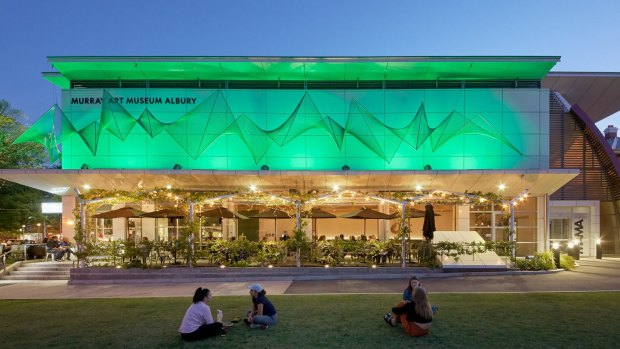
The Murray Art Museum, Albury-Wodonga.
But the permanent collection of 19th-century international and Australian art, as well as contemporary works from the likes of Patricia Piccinini, make the 1887-established gallery a must-visit at any time. During my visit, I discover some new favourite pieces, such as The Arab Blacksmith, an incredible work of realism by English painter, Thomas Sheard.
I could base myself in Bendigo for days, exploring the grand architecture and sophisticated antique and private gallery scene as well as visiting the surrounding small towns which offer self-guided heritage and history trails (bendigoregion.com.au).
But I must push on, as my itinerary demands, with a three-hour drive to the twin NSW-Victoria border cities of Albury-Wodonga, home to almost 100,000 [people. It's here I'm actually going to slow down a bit, and I check in for two nights at the beautiful Circa 1928 (circahotels.com), a boutique hotel in an old bank in Albury's CBD.
As well as spacious suites themed around famous artists born in 1928 (mine is the Pro Hart suite while the other, in stark contrast, is dedicated to Andy Warhol), the lobby doubles as a gallery space, displaying works of local artists for sale, as well as many pieces drawn from their own Asia-Pacific travels.
On arrival the owners, Kevin and Ririn Yaxley, invite me to join them for a glass of wine and a chat about what's on display in the hotel, one part of Albury-Wodonga's thriving cultural scene. An early cultural success in the Twin Cities was The Flying Fruit Fly Circus acrobatic school.
A short walk from Circa 1928, the Murray Art Museum Albury (mamalbury.com.au), has only been in its current modern, airy incarnation since 2015 but it attracts some 100,000 visitors a year. This is one ambitious institution, focused on encouraging conversation and thought about contemporary issues through art.
It's also home to the acquisitive National Photography Prize, the oldest of its kind in Australia, which contributes to MAMA having an important accumulation. MAMA also has a busy bookable schedule of workshops and "artist-in-conversation" events (not to mention a great restaurant).
Likewise Burraja Gallery, dedicated to contemporary Aboriginal art from across the shared Indigenous country of the border/north east regions, hosts weaving workshops (burrajagallery.org.au). The art in this atmospheric old retail shop space is for sale, and ranges in price points and styles.
I snap up some inexpensive carved bowls, and think I'd like to come back and invest in one of the statement paintings that dazzle from the walls. Next, is the privately-owned art gallery, Art Partners Australia (artpartners.com.au), where I meet founder Jacinta Miriams.
She tells me how she built her consultancy business on supplying art to hospitals, corporates and private collectors, while at her shop front, she showcases outstanding regional talent.
Out the back in a large studio space I also meet the talented Robert Klein-Boonschate, a long-time friend and collaborator of Miriams' and watch him as he creates his canvas magic.
It's a social space, with exhibition openings as well as art workshops via the adjacent art supplies shop. They might be themed around watercolours for beginners, printing or drawing – but each is led by a practising artist.
DAY FIVE: ALBURY-WODONGA – RUTHERGLEN – BENALLA – MANSFIELD, 200 KILOMETRES
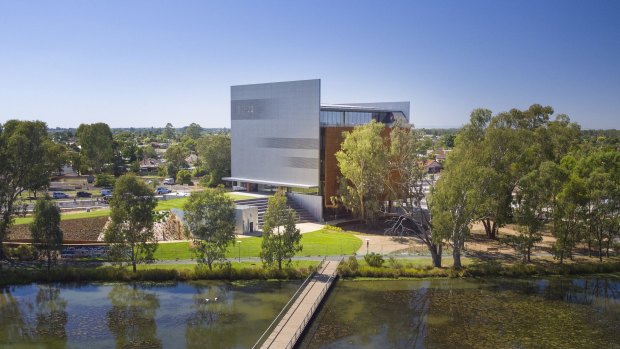
Shepparton Art Museum, Victoria. Photo: John Gollings
After a delicious in-room breakfast at Circa 1928, I hit the road and drive 30 minutes west to the lovely vineyard encircled hamlet of Rutherglen, where the De Bortoli cellar door is home to the Aboriginal Exhibitions Gallery, a joint venture between the winery and art collector, Hans Sip, featuring works by the artists of the Lockhart River Arts Indigenous Corporation for purchase (debortoli.com.au).
Then, it's a little over an hour south-east to the pretty river city of Benalla (enjoybenalla.com.au). Victoria is renowned for its silo art with works just north of town warranting a whole day in its own right. But I settle on Devenish, with a population of under 200, to gain a taste and admire the majestic Graincorp silos with Cam Scale murals dedicated to Australian service people (nearttrail.org.au).
Benalla city, with a population of more than 14,000, is home to the Wall to Wall Festival (walltowallfestival.com) of street art and my visit doesn't coincide, but still I find smashing permanent examples of this vibrant creative form throughout the CBD; they number more than 50 pieces.
However, my primary stop is the Benalla Art Gallery (benallaartgallery.com.au). It's easy to spot – a striking modernist form, designed by noted architects Philip Sargeant and Colin Munro, which overhangs the ornamental Lake Benalla one way, and butts against the picturesque botanic gardens the other.
The permanent collection spanning three centuries is nationally important with names such as Streeton, McCubbin, Dobell, Tucker and Preston represented. But it's the roster of special exhibitions for which the gallery has earned its contemporary reputation.
This gallery's mix of the local and national renders it a standout and I make a pact with myself to commit to watching its calendar of exhibitions and events to return.
From Benalla, it's a 50-minute detour north-west for a visit to the Shepparton Art Museum (sheppartonartmuseum.com.au) or alternatively or even as well, a 45-minute drive due south along the Midland Highway to Mansfield (mansfieldmtbuller.com.au), a town of around 5000 people, more widely known as a centre for skiers and mountain bikers due to its proximity to Mount Buller.
But for locals, and visitors in the know, it's a place that boasts a thriving cultural heart. The Delatite Hotel (thedelatitehotel.com.au) for instance, hosts regular art showings and live music, as does the Mansfield Regional Produce Store (theproducestore.com.au), which, as well as offering local produce, local art and local music, is very much a community hub.
Fifteen minutes out of town, on a working goat stud farm, I find my accommodation, BullerRoo, a beautiful sky box of a place affording inspiring views from its huge windows and clever rooftop barbecue deck. BullerRoo (aviewtoahill.com.au) itself is a work of art, by architects DCS Design, with lovingly crafted features by the owners. I relax in front of the roaring fireplace.
DAY SIX, MANSFIELD – YERING – MELBOURNE: 188 KILOMETRES
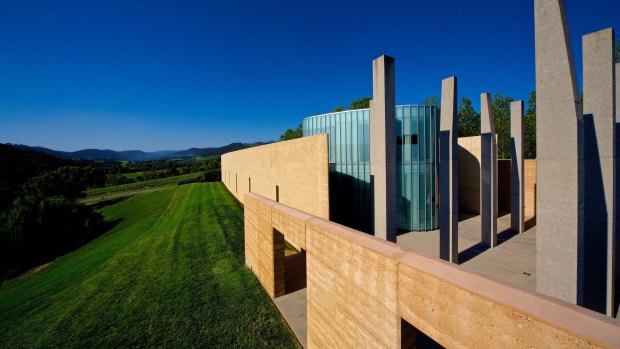
TarraWarra Museum of Art.
It's just under two hours to Yering Station Winery in the Yarra Valley, home to Victoria's first vineyard. The Rathbone family who have owned it since 1996 have crafted the property into not only a major award-winning wine producer with signature restaurant and cellar door garnering many accolades, but also a centre for visual art (yering.com).
In the 1859 cellar door building, and the Winery Viewing Gallery, the large walls are given over to specially-commissioned exhibitions, the proceeds from which go to My Room Children's Cancer Charity, while sculptures are always on display in the grounds, including the dedicated Sculpture Terrace. It's a remarkably generous asset, against the backdrop of expansive district views.
A short drive away, I visit TarraWarra Museum of Art (twma.com.au), founded by philanthropists Eva and Marc Besen, passionate collectors of Australian art since the 1950s, who created the foundations of the gallery's formidable collection while also driving the design for the gracious modernist lines of the building it inhabits.
Festivals, music events, talks and special exhibitions are just some of the cultural activities that take place here.
It's only a 10-minute drive from TarraWarra to pretty Dixons Creek, where I find the working farm, and farmstay property, Glenlowren, its bucolic vistas the epitome of why the Yarra Valley is so cherished by Victorians. My accommodation is in the Nissen Hut, right on the edge of the property's wetlands, its vaulted shape harbours classic country luxury, including a spa bath, full kitchen and sumptuous lounge area (glenlowren.com.au).
After a lovely night's sleep in the midst nature's peacefulness, I head back home to Melbourne both enriched and enlightened.
Julietta Jameson travelled as a guest of Visit Victoria (visitvictoria.com).
FIVE BEST MELBOURNE ART EXPERIENCES
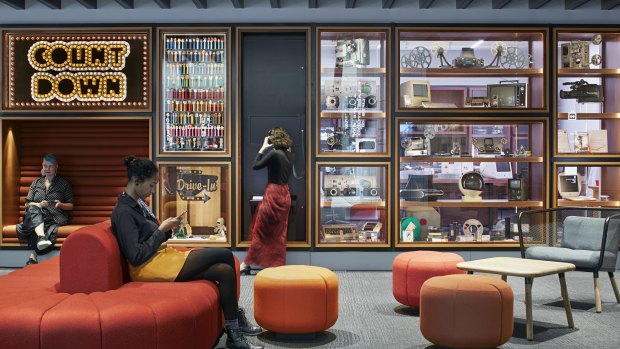
The Digital Preservation Lab at ACMI through the window displays in Edie Kurzer's Wall of Objects.Credit: Shannon McGrath
NATIONAL GALLERY OF VICTORIA
One of Australia's finest, the NGV attracts top-class international exhibitions, such as the current French Impressionism from the Museum of Fine Arts, Boston and Goya: Drawings from the Prado Museum. See ngv.vic.gov.au
HEIDE MUSEUM OF MODERN ART
This beautiful property began life in 1934 as the home of artists John and Sunday Reid. The philosophy and attitude of the Reids and their cohort still influences the innovative mission of engagement here. See heide.com.au
MELBOURNE MUSEUM
Exhibitions with the wow factor are the calling card of Melbourne Museum. The current Treasures of the Natural World brings some of the world's most rare objects and specimens to Australia, courtesy of the Natural History Museum, London. See museumsvictoria.com.au
THE IAN POTTER CENTRE
The world's first major gallery dedicated exclusively to Australian art, the NGV-run Ian Potter Centre's 20 galleries at Federation Square includes a suite dedicated to Aboriginal and Torres Strait Islander art. See ngv.vic.gov.au
Sign up for the Traveller Deals newsletter
Get exclusive travel deals delivered straight to your inbox. Sign up now.